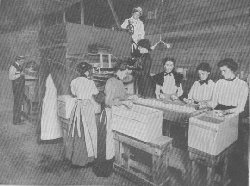|
Egg candling by machinery is one of the modern wonders of the poultry world. In ancient times eggs were held up to the sun or some strong light, and thereby tested as to their freshness. This process was considered very slow and far from satisfactory.
In this, several Englishmen participated, but it was left for a "down-east" Yankee to devise a machine that would candle eggs, and do it with such rapidity that it was found necessary to have five women to remove the eggs after having passed through the inspection house. In 1892, a machine of this kind was put into one of the big packing houses at the Chicago stock yards, and within a week it was running so smoothly that 27,080 eggs were candled in an hour's time. The egg candler consists of a box or house, eight feet square and ten feet high. Through this runs a shallow trough. Inside the house are a set of rollers, which work in screw fashion, and over these rollers the eggs pass while being inspected. Underneath the rollers is a set of powerful electric arc lights. Two women stand at the feeding end of the candler, and pour eggs upon an endless belt that carries them in upon the rollers. As they roll along the inspector picks out the bad and broken eggs. The former he consigns to the "fertilizer" tank, and the latter, to an upper set of rollers which carries them out to a woman in waiting, who places them in a box marked "broken," or, if they are badly cracked, breaks them into a can. The eggs that are broken into the can are stirred together, and when the can is filled, it is conveyed to the cooler, where the contents are frozen and, later, sold to bakeries. The good eggs are placed in cases and put into cold storage. It is not an infrequent thing for the packers to have 15,000,000 eggs in storage. EVOLVING NEW KINDS OF WHEAT |
